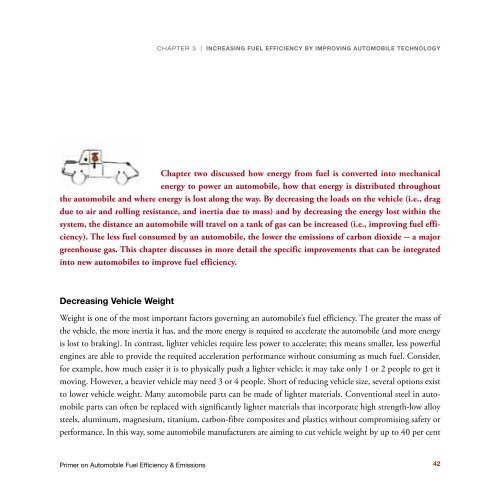Primer on Automobile Fuel Efficiency and Emissions - Pollution Probe
Primer on Automobile Fuel Efficiency and Emissions - Pollution Probe
Primer on Automobile Fuel Efficiency and Emissions - Pollution Probe
You also want an ePaper? Increase the reach of your titles
YUMPU automatically turns print PDFs into web optimized ePapers that Google loves.
CHAPTER 3 | INCREASING FUEL EFFICIENCY BY IMPROVING AUTOMOBILE TECHNOLOGY<br />
AUTOMOBILE ENERGY USE, EFFICIENCY AND<br />
Chapter two discussed how energy from fuel is c<strong>on</strong>verted into mechanical<br />
energy to power an automobile, how that energy is distributed throughout<br />
the automobile <strong>and</strong> where energy is lost al<strong>on</strong>g the way. By decreasing the loads <strong>on</strong> the vehicle (i.e., drag<br />
due to air <strong>and</strong> rolling resistance, <strong>and</strong> inertia due to mass) <strong>and</strong> by decreasing the energy lost within the<br />
system, the distance an automobile will travel <strong>on</strong> a tank of gas can be increased (i.e., improving fuel efficiency).<br />
The less fuel c<strong>on</strong>sumed by an automobile, the lower the emissi<strong>on</strong>s of carb<strong>on</strong> dioxide -- a major<br />
greenhouse gas. This chapter discusses in more detail the specific improvements that can be integrated<br />
into new automobiles to improve fuel efficiency.<br />
Decreasing Vehicle Weight<br />
Weight is <strong>on</strong>e of the most important factors governing an automobile’s fuel efficiency. The greater the mass of<br />
the vehicle, the more inertia it has, <strong>and</strong> the more energy is required to accelerate the automobile (<strong>and</strong> more energy<br />
is lost to braking). In c<strong>on</strong>trast, lighter vehicles require less power to accelerate; this means smaller, less powerful<br />
engines are able to provide the required accelerati<strong>on</strong> performance without c<strong>on</strong>suming as much fuel. C<strong>on</strong>sider,<br />
for example, how much easier it is to physically push a lighter vehicle; it may take <strong>on</strong>ly 1 or 2 people to get it<br />
moving. However, a heavier vehicle may need 3 or 4 people. Short of reducing vehicle size, several opti<strong>on</strong>s exist<br />
to lower vehicle weight. Many automobile parts can be made of lighter materials. C<strong>on</strong>venti<strong>on</strong>al steel in automobile<br />
parts can often be replaced with significantly lighter materials that incorporate high strength-low alloy<br />
steels, aluminum, magnesium, titanium, carb<strong>on</strong>-fibre composites <strong>and</strong> plastics without compromising safety or<br />
performance. In this way, some automobile manufacturers are aiming to cut vehicle weight by up to 40 per cent<br />
<str<strong>on</strong>g>Primer</str<strong>on</strong>g> <strong>on</strong> <strong>Automobile</strong> <strong>Fuel</strong> <strong>Efficiency</strong> & Emissi<strong>on</strong>s<br />
42
















